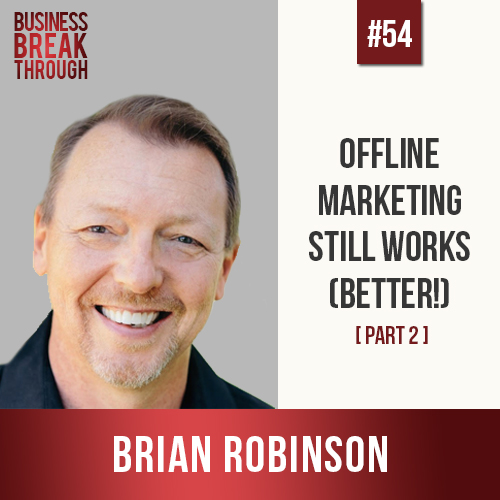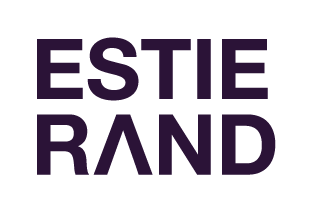Brian Robinson has mastered the art of offline marketing in 2019, an art that has been almost forgotten, but is still highly successful! In this episode, Brian gives us a step-by-step run-through of how to create a direct mailing campaign, covering everything from the size of the envelope to the content of the letter.
He also shares his journey where he went from working in corporate sales for Coca-Cola USA and Johnson & Johnson, to doing cold sales for a brand new and unknown start-up that sold on-hold messages to banks and credit unions. Plus, Brian shares his struggle of trying to sell on-hold messages to business owners who are not aware that their customers are ever put on hold. Tune in for an episode packed with intriguing stories and incredible value!
Teaser:
My Guest: Brian Robinson
Brian Robinson is a sales and marketing expert, best-selling author and coach. He has worked in sales and marketing with some of the best-known companies in the world, including Coca-Cola USA and Johnson & Johnson.
Upon leaving his corporate career, he helped launch a successful startup where he was the first person in the history of the industry to sell more than one million dollars in business in twelve months—entirely by phone. His over two-decades-worth of in-the-trenches, battle-tested face-to-face and phone-presentation knowledge can benefit virtually anyone, from Fortune 500 companies to entrepreneurial ventures.
Brian is the author of the Amazon #1 Best-Seller, THE SELLING FORMULA: 5 Steps for Instant Sales Improvement. Brian and his wife Cindy reside in the Oklahoma City Area and have eight children – which could be the top of an entire podcast in and of itself!
Pivotal Moments:
Started his career working for Coca Cola USA where he learned the basics of how to sell.
Left after three and a half years to work for Johnson & Johnson, where he worked in four different divisions over 13 years.
Was at an incredibly successful point where 90% of all potential customers were already using Johnson & Johnson products, when a friend offered him the opportunity to start a business selling on-hold messages to banks and credit unions.
Decided that he would need to exert too much effort to sell to the last 10% of potential customers, and after four months of consideration, decided to join his friend.
Brought the business to $1M in twelve months by cold calling bank managers to schedule appointments. Once he had a confirmed meeting, he would set out on the road and on the way, he would call other bank managers within an X-mile radius to set more appointments in that area.
By the early 2000s was at a point where he was on the road three to four days a week, driving 1000-1500 miles, when his wife gave birth to twins (he already had six children), forcing him to get off the road.
Switched to using mailings and pre-recorded messages to generate warm leads instead of driving the country to meet cold leads.
Today Brian has expanded to selling on hold-messages, in-lobby digital signage (content for flat panel TVs in lobbies) and overhead music for the lobbies. He uses a range of different sales techniques including conferences and direct mailing campaigns using hand-written letters.
The Advice:
Offline Marketing Works!
Offline marketing still works, even in 2019. In fact, because most people don’t do it anymore, there is much less clutter and it’s much easier to penetrate. Here is a step by step process to create your offline marketing campaign.
1. List Brokers
The first step for creating a direct mailing campaign is to buy a list of relevant addresses that you can send mail to. You can find plenty of list brokers online, but not all of them will provide high-quality lists with accurate information. Before buying a list, ask for a random sample and personally test the list, by manually verifying a percentage of the details. This will give you a sense of how accurate the list is.
2. Your Mail: Externals
Some tips on how to create the best mailing are:
- Use bumpy mail i.e. if it feels like there is something inside, people are much more likely to open it.
- Use a 6″ x 9″ baby blue envelope.
- Use an 8.5″ x 11″ inch standard size paper, folded in half and a 12pt font.
- Write the address by hand (yes a real, human hand).
- The return address can be printed, but make sure that you never put a company name on the return address.
- Either use first class stamps because they carry lots of legitimacy, or order special bulk rate stamps that look similar to first-class ones.
3. Your Mail: Internals
Now that the envelope ready, is what does the letter inside look like?
- Letterheads can either make people throw away your mail without reading it, or it can give credibility and authenticity. Test out for what works best with your audience.
- Write a hand-written note on the top of the letter, addressed by name to the recipient that says:
“<<<NAME>>, thanks for taking a look at this. I look forward to your opinion.”
This note immediately builds a connection with the lead and gets people to read at least the first sentence of the letter.
- The content of the letter should be very short and should direct people to a web page where they can find out about your product if they are interested.
- Sign the letter by hand.
- After the signature, there is a postscript with another call to action and a URL.
A great idea is to highlight or underline something in the postscript so it looks like you took time to work on this letter.
4. Creating Your Website
Once you have created your mail, you need to set up the landing page that you are directing your leads to.
It is very easy to buy a URL that ties in directly to the key benefit of what you are trying to sell. e.g. clearestevidence.com for the highest resolution security camera.
The landing page itself contains a video that outlines the following:
- The three key pain points of the target market.
- What we discovered about that problem
- How we help to solve it
- Call to action, directing people to a link where they can fill in their name and email address.
The video should last for three to five minutes.
5. Following Up With Leads
Once a lead comes to your website and fills out the form, you need to call them immediately, within an hour or less. Don’t wait because you now know that they are highly interested in your product and you don’t want to lose that. Get on the phone and book a meeting with them at a future date- the sooner the better.
6. Selling Your Product
Before you meet with your lead (in person, via video conference or phone call), you need to prepare some questions to ask your lead. People appreciate the depth and quality of your questions because it shows that you know what your service can provide and that you understand their pain points.
Use the following process to draw up a list of relevant and meaningful questions:
- List as many features of your product as possible. For example, the ability to update content online.
- For each feature, write down the benefits. There are usually multiple benefits for each feature. For example, you can update content anytime, anyplace.
- Write up some questions related to each benefit. e.g. If there was a way you can update video content within minutes, would that be of value to you?
Then when you meet with your lead, tell them that you are going to be asking questions and writing down the answers. The prospect becomes more thoughtful when they know that you are writing down the answers. Then use the answers you collect to circle back and recap what they said so that you can close the deal.
7. Keys to Success
Two critical points to keep in mind when creating your campaign are:
- You need to articulate in the language of your leads. To find out what your potential customers are saying, have an honest one-on-one conversation with your current customers to get a feel for the language that they are using.
- At each stage of your funnel, you want to have only one single required action e.g. the only required action of people who receive a letter is to open it. Once they open it, the only thing you want them to do is to go your landing page.
The Struggle:
The biggest problem that Brian faces when trying to sell his on-hold messaging service to potential customers, is that most business owners are not lying awake at night wondering what customers are hearing when they are put on hold! In fact, most business owners don’t think that their customers are ever put on hold in the first place. Brian’s challenge is to figure out the right questions to ask potential customers to help them realize that what is playing on their phone systems is important and that the solution Brian offers is very relevant and very valuable to them.
The Breakthrough:
If Brian’s customers are not lying awake wondering what is playing on-hold on their phone systems, what are they worrying about at 2 AM?
Among other questions, most business owners worry about how to retain current customers and how to promote their products to new ones. Brian helps to solve both of these problems with his on-hold messages and therefore can ask questions around these challenges to help business owners realize that Brian is offering a service that is extremely valuable to them.
Quote:
Questions are the key to life.
Resources & Links:
For part 1 of this episode, where you can hear Brian’s incredible journey, go to estierand.com/54-1
Did you enjoy this episode? Then subscribe to my podcast on iTunes, so you can get automatic updates whenever another episode goes live (and you will be helping me get to #1 on iTunes, making us all cooler in the process!)
About the author, Estie Rand
I love turning ideas into money, and helping others do the same. I help small business owners with everything from marketing to fiscal management, business plans to staffing, database architecture to work/life balance coaching and I love it all! What do you need help with today?


